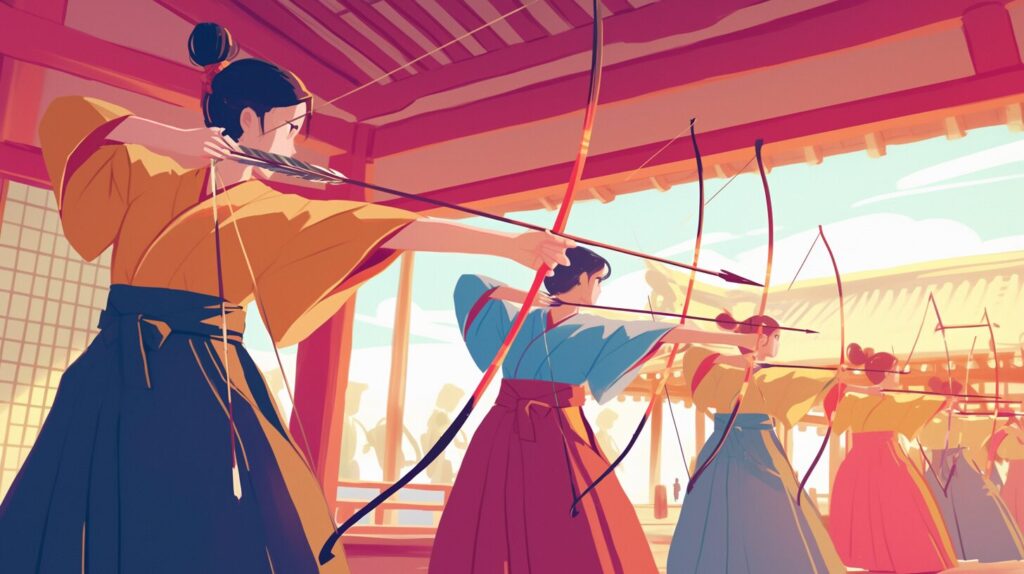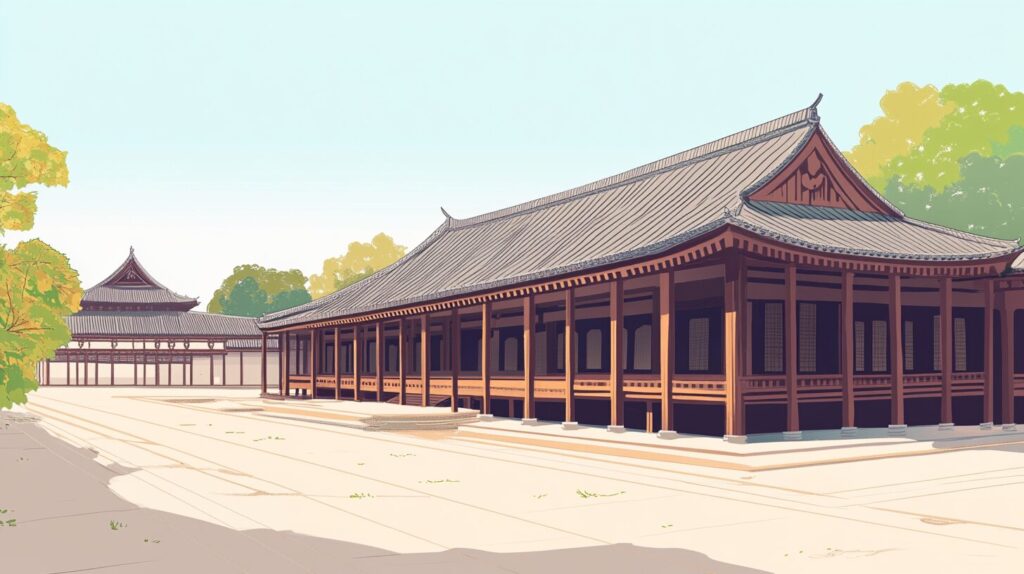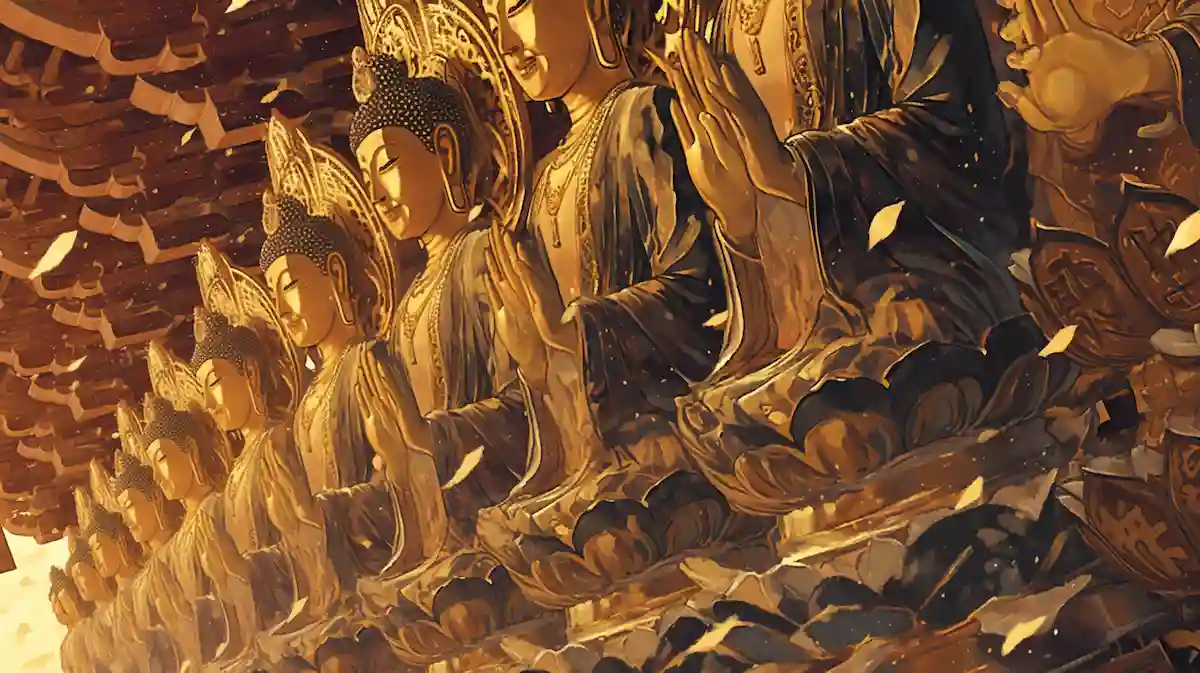蓮華王院 三十三間堂を英語で説明・紹介するための基本情報と、英会話に役立つ表現をシンプルでわかりやすい英語で紹介します。
英会話ダイアローグ・概要・10の質問を通して、三十三間堂に関する英語表現を学びます。
英語
英会話ダイアローグを読む前に知っておくと良い前提知識と情報です。
- 三十三間堂の基本情報
- 正式名称:は蓮華王院(れんげおういん)
- 1164年、後白河上皇によって平清盛の支援で建立
- 1266年に鎌倉時代に再建
- 三十三間堂の特徴
- 名前の由来: 「柱と柱の間が33間ある」という建築構造に基づいている
- 1,001体の観音像:中央の千手観音坐像1体と、両脇に500体ずつの立像
- 風神・雷神像: 本堂両端に位置し、迫力とダイナミックな表現が魅力
- 二十八部衆像: 観音像を守る28体の護法神の像が配置
- 通し矢
- 毎年1月に開催される弓道の伝統行事
- 弓手が120メートルの堂内で矢を放つ
2人が三十三間堂について話しています。
三十三間堂の歴史や特徴、1,001体の観音像や風神・雷神像、通し矢の行事などを話題にしています。
会話 / dialogue

Hey Key, have you heard of Sanjusangendo? I’m thinking of visiting it soon, but I don’t know much about it.

Oh, Sanjusangendo? Yes, it’s one of the most famous temples in Kyoto! It’s well-known for its 1,001 Kannon statues.

Wait, 1,001 statues? That’s incredible! Why are there so many?

Well, Kannon is the goddess of mercy in Buddhism, and the 1,001 statues represent her compassion. There’s a large seated Kannon in the middle and 500 smaller ones on each side. They say each one has unique details, which is amazing.

That sounds impressive. Is there any special meaning behind the name “Sanjusangendo”?

Good question! “Sanjusangendo” means “33 spaces between pillars” in Japanese. It’s designed this way because Kannon is believed to take on 33 different forms to save people.

That’s really symbolic. What else can you tell me about its history?

Oh, you’ll like this! The temple was first built in 1164 by Emperor Go-Shirakawa, and it was supported by Taira no Kiyomori, one of the most powerful leaders of the time.

That’s really interesting. So, it has connections to famous historical figures?

Exactly. It burned down later, but the current hall was rebuilt in 1266, during the Kamakura period. It’s been standing for centuries.

Wow, the fact that it’s survived so long makes it even more impressive. What else can you see there?

Oh, you’ll also find the Wind God (Fujin) and Thunder God (Raijin) statues at each end of the hall. They’re super dynamic and look almost alive.

Wind God and Thunder God? That sounds powerful. I’d love to see them up close.

You’d definitely love it. And don’t forget the 28 guardian statues. They protect the Kannon and have really strong, lifelike poses. Each one is different.

That’s incredible craftsmanship! By the way, I heard the hall itself is pretty special.

Yes, the main hall is huge—120 meters long! It’s actually one of the longest wooden buildings in Japan. You can walk along it and feel the history.

That’s impressive. So, is there anything special happening at Sanjusangendo throughout the year?

Oh, definitely! Every January, they hold a famous archery event called Toshiya. Archers shoot arrows along the entire length of the hall.

That sounds amazing! I love traditional events like that. Do a lot of people visit during this time?

Yes, January is super popular because of Toshiya. But spring, during the cherry blossoms, and autumn, with the fall leaves, are also beautiful times to visit.

I see. It sounds like it’s popular all year round. How can I get there?

It’s easy! From Kyoto Station, you can take a bus or even walk—it’s only about 15 minutes away.

Perfect! I’ll definitely check it out. Seeing those 1,001 Kannon statues and the Wind and Thunder Gods must be unforgettable.

It really is. Sanjusangendo combines history, art, and spirituality in one place. I’m sure you’ll love it!

Thanks, Key. I’m really excited now—I’ll plan my trip for next weekend!

Enjoy, Mack! Don’t forget your camera—those statues are worth remembering!
概要 / Overview
「蓮華王院 三十三間堂」について、理解を深めるための「英語での概要」です。
蓮華王院 三十三間堂

Introduction
Sanjusangendo is a famous Buddhist temple in Kyoto, Japan. Its official name is Rengeo-in. The temple was first built in 1164 by Emperor Go-Shirakawa with support from Taira no Kiyomori, a powerful leader at that time. Although the original building burned down, the current structure was rebuilt in 1266 during the Kamakura period. Sanjusangendo is now a National Treasure of Japan and attracts visitors from all over the world.
The Meaning of “Sanjusangendo”
The name “Sanjusangendo” means “33 spaces between pillars.” This design represents the 33 forms of Kannon, the goddess of mercy. The main hall, which is about 120 meters long, is one of the longest wooden buildings in Japan. Visitors can walk through this impressive space and enjoy its historical beauty.
1,001 Kannon Statues
The biggest highlight of Sanjusangendo is its 1,001 statues of Kannon. In the center of the hall is a large seated Kannon statue, and on each side are 500 standing statues. Each statue is slightly different, showing the amazing craftsmanship of the Heian and Kamakura periods. The golden statues create a sacred and peaceful atmosphere, leaving visitors in awe.
Wind and Thunder Gods
At each end of the main hall, you can see the Wind God (Fujin) and Thunder God (Raijin) statues. These dynamic sculptures represent the power of nature. The Wind God holds a bag of wind, while the Thunder God carries drums. They are masterpieces of Japanese Buddhist art and symbolize protection.
The Archery Tradition: Toshiya
Every January, Sanjusangendo hosts an archery event called Toshiya. During this event, archers shoot arrows across the entire length of the hall. This tradition started in the Edo period and is a popular attraction today. It is also a chance to see a unique part of Japanese culture.
Visiting Sanjusangendo
Sanjusangendo is located near Kyoto Station, just a 15-minute walk or a short bus ride. It is a popular destination year-round, especially in spring when cherry blossoms bloom and in autumn during the fall foliage season. The temple offers a peaceful and spiritual experience for all visitors.
Sanjusangendo combines history, art, and spirituality, making it a must-visit destination in Kyoto. Whether you come for the impressive statues, the long history, or the unique events, it will leave a lasting impression.
10の質問 / 10 questions
「蓮華王院 三十三間堂」について、理解を深めるための「英語での10の質問」です。
1: What is Sanjusangendo?
Sanjusangendo is a famous Buddhist temple in Kyoto, Japan. It is known for its long wooden hall and 1,001 Kannon statues. Its official name is Rengeo-in.
2: When was Sanjusangendo built?
It was first built in 1164 by Emperor Go-Shirakawa with the support of Taira no Kiyomori. The current structure was rebuilt in 1266 after a fire.
3: What does “Sanjusangendo” mean?
The name means “33 spaces between pillars” in Japanese. This design represents the 33 forms of Kannon, the goddess of mercy.
4: What are the 1,001 Kannon statues?
The 1,001 Kannon statues are golden Buddhist statues inside the main hall. They include one large seated Kannon and 500 standing statues on each side. Each one is unique.
5: What are the Wind God and Thunder God statues?
The Wind God (Fujin) and Thunder God (Raijin) statues are located at both ends of the main hall. They represent natural forces and are famous for their dynamic designs.
6: Why is Sanjusangendo famous?
It is famous for its large collection of Buddhist statues, its long history, and its unique wooden architecture. It is also a National Treasure of Japan.
7: What is Toshiya?
Toshiya is an annual archery event held at Sanjusangendo in January. Archers shoot arrows across the 120-meter-long hall. It is a tradition from the Edo period.
8: How long is the main hall of Sanjusangendo?
The main hall is about 120 meters long, making it one of the longest wooden buildings in Japan.
9: When is the best time to visit Sanjusangendo?
The best times are January for Toshiya, spring for cherry blossoms, and autumn for fall leaves. It is beautiful and peaceful all year round.
10: How can you get to Sanjusangendo?
Sanjusangendo is a 15-minute walk or a short bus ride from Kyoto Station. It is easy to access from the city center.

和訳付
会話 / dialogue

Hey Key, have you heard of Sanjusangendo? I’m thinking of visiting it soon, but I don’t know much about it.
ねえキー、三十三間堂って聞いたことある?近々行こうと思ってるんだけど、あまり詳しくなくてさ。

Oh, Sanjusangendo? Yes, it’s one of the most famous temples in Kyoto! It’s well-known for its 1,001 Kannon statues.
ああ、三十三間堂?もちろん知ってるよ!京都でも有名なお寺の一つだよ。特に、1,001体の観音像で有名なんだ。

Wait, 1,001 statues? That’s incredible! Why are there so many?
ちょっと待って、1,001体もあるの?すごいな!なんでそんなにたくさんあるの?

Well, Kannon is the goddess of mercy in Buddhism, and the 1,001 statues represent her compassion. There’s a large seated Kannon in the middle and 500 smaller ones on each side. They say each one has unique details, which is amazing.
観音は仏教で慈悲の女神なんだ。その1,001体は彼女の慈悲を表しているんだよ。中央に大きな座った観音像があって、両脇に500体ずつ小さな観音像が並んでる。それぞれ細かい違いがあって、すごいよ。

That sounds impressive. Is there any special meaning behind the name “Sanjusangendo”?
すごいな。「三十三間堂」って名前にも何か特別な意味があるの?

Good question! “Sanjusangendo” means “33 spaces between pillars” in Japanese. It’s designed this way because Kannon is believed to take on 33 different forms to save people.
いい質問だね!「三十三間堂」は日本語で「柱の間が33間ある」って意味なんだ。観音は人々を救うために33の姿に変わると信じられていて、それにちなんでデザインされているんだよ。

That’s really symbolic. What else can you tell me about its history?
それはすごく象徴的だね。他に歴史について何か教えてくれる?

Oh, you’ll like this! The temple was first built in 1164 by Emperor Go-Shirakawa, and it was supported by Taira no Kiyomori, one of the most powerful leaders of the time.
それなら興味持つと思うよ!三十三間堂は1164年に後白河上皇が建てたんだ。当時の有力者、平清盛の支援を受けてね。

That’s really interesting. So, it has connections to famous historical figures?
面白いね!じゃあ、有名な歴史人物とも関わりがあるんだ?

Exactly. It burned down later, but the current hall was rebuilt in 1266, during the Kamakura period. It’s been standing for centuries.
その通りだよ。その後焼失したけど、現在の本堂は鎌倉時代の1266年に再建されたんだ。それ以来、何世紀も残っているんだよ。

Wow, the fact that it’s survived so long makes it even more impressive. What else can you see there?
わあ、そんなに長い間残ってるのはさらにすごいね。他に何が見られるの?

Oh, you’ll also find the Wind God (Fujin) and Thunder God (Raijin) statues at each end of the hall. They’re super dynamic and look almost alive.
ああ、本堂の両端には風神像と雷神像もあるよ。すごくダイナミックで、まるで生きているみたいなんだ。

Wind God and Thunder God? That sounds powerful. I’d love to see them up close.
風神と雷神?力強そうだね。近くで見てみたいな。

You’d definitely love it. And don’t forget the 28 guardian statues. They protect the Kannon and have really strong, lifelike poses. Each one is different.
絶対気に入ると思うよ。それに28体の守護神像も忘れないで。観音像を守っていて、すごくリアルで力強いポーズをしてるんだ。それぞれ個性があるんだよ。

That’s incredible craftsmanship! By the way, I heard the hall itself is pretty special.
それは本当にすごい職人技だね!ところで、本堂自体も特別なんだよね?

Yes, the main hall is huge—120 meters long! It’s actually one of the longest wooden buildings in Japan. You can walk along it and feel the history.
そう、本堂は全長120メートルもあって、日本で最も長い木造建築の一つなんだ。歩きながらその歴史を感じることができるよ。

That’s impressive. So, is there anything special happening at Sanjusangendo throughout the year?
すごいな。ところで、三十三間堂では年間を通して何か特別なイベントがあるの?

Oh, definitely! Every January, they hold a famous archery event called Toshiya. Archers shoot arrows along the entire length of the hall.
もちろん!毎年1月には「通し矢」という有名な弓道大会が開催されるよ。射手が本堂の全長を使って矢を放つんだ。

That sounds amazing! I love traditional events like that. Do a lot of people visit during this time?
すごく面白そう!そういう伝統的なイベント、大好きだよ。その時期は多くの人が訪れるの?

Yes, January is super popular because of Toshiya. But spring, during the cherry blossoms, and autumn, with the fall leaves, are also beautiful times to visit.
うん、1月は通し矢があるからすごく人気だよ。でも、春の桜の季節や秋の紅葉の季節もとても美しい時期だよ。

I see. It sounds like it’s popular all year round. How can I get there?
なるほど。一年中人気みたいだね。どうやって行けるの?

It’s easy! From Kyoto Station, you can take a bus or even walk—it’s only about 15 minutes away.
簡単だよ!京都駅からバスに乗るか、歩いても行ける。だいたい15分くらいで着くよ。

Perfect! I’ll definitely check it out. Seeing those 1,001 Kannon statues and the Wind and Thunder Gods must be unforgettable.
最高だね!絶対に行ってみるよ。1,001体の観音像や風神雷神像を見るのはきっと忘れられない経験になりそうだ。

It really is. Sanjusangendo combines history, art, and spirituality in one place. I’m sure you’ll love it!
本当にそうだよ。三十三間堂は歴史、芸術、そして精神性が一体になった場所なんだ。きっと気に入ると思うよ!

Thanks, Key. I’m really excited now—I’ll plan my trip for next weekend!
ありがとう、キー。今すごく楽しみになったよ!次の週末に計画を立てるね!

Enjoy, Mack! Don’t forget your camera—those statues are worth remembering!
楽しんでね、マック!カメラを忘れないでね。あの像たちは絶対に記念に残るよ!
概要 / Overview
蓮華王院 三十三間堂

Introduction
Sanjusangendo is a famous Buddhist temple in Kyoto, Japan. Its official name is Rengeo-in. The temple was first built in 1164 by Emperor Go-Shirakawa with support from Taira no Kiyomori, a powerful leader at that time. Although the original building burned down, the current structure was rebuilt in 1266 during the Kamakura period. Sanjusangendo is now a National Treasure of Japan and attracts visitors from all over the world.
三十三間堂は、日本の京都にある有名な仏教寺院です。正式名称は蓮華王院(れんげおういん)です。この寺院は、1164年に後白河上皇によって建てられ、当時の有力者である平清盛の支援を受けました。元の建物は焼失しましたが、現在の建物は鎌倉時代の1266年に再建されました。三十三間堂は現在、日本の国宝として指定されており、世界中から観光客が訪れています。
The Meaning of “Sanjusangendo”
The name “Sanjusangendo” means “33 spaces between pillars.” This design represents the 33 forms of Kannon, the goddess of mercy. The main hall, which is about 120 meters long, is one of the longest wooden buildings in Japan. Visitors can walk through this impressive space and enjoy its historical beauty.
「三十三間堂」という名前は「柱の間が33間ある」ことを意味します。この設計は、慈悲の女神である観音が持つ33の姿を表しています。本堂は全長約120メートルあり、日本で最も長い木造建築の一つです。訪れる人々はこの壮大な空間を歩きながら、その歴史的な美しさを楽しむことができます。
1,001 Kannon Statues
The biggest highlight of Sanjusangendo is its 1,001 statues of Kannon. In the center of the hall is a large seated Kannon statue, and on each side are 500 standing statues. Each statue is slightly different, showing the amazing craftsmanship of the Heian and Kamakura periods. The golden statues create a sacred and peaceful atmosphere, leaving visitors in awe.
三十三間堂の最大の見どころは、1,001体の千手観音像です。堂内の中央には大きな座った観音像があり、その両側に500体ずつの立像が並んでいます。それぞれの像は微妙に異なり、平安時代や鎌倉時代の素晴らしい職人技を物語っています。金色に輝く像は神聖で静かな雰囲気を生み出し、訪れる人々を感動させます。
Wind and Thunder Gods
At each end of the main hall, you can see the Wind God (Fujin) and Thunder God (Raijin) statues. These dynamic sculptures represent the power of nature. The Wind God holds a bag of wind, while the Thunder God carries drums. They are masterpieces of Japanese Buddhist art and symbolize protection.
本堂の両端には、風神像と雷神像が見られます。これらのダイナミックな彫刻は自然の力を表現しています。風神は風の袋を持ち、雷神は太鼓を持っています。これらは日本仏教美術の傑作であり、守護の象徴とされています。
The Archery Tradition: Toshiya
Every January, Sanjusangendo hosts an archery event called Toshiya. During this event, archers shoot arrows across the entire length of the hall. This tradition started in the Edo period and is a popular attraction today. It is also a chance to see a unique part of Japanese culture.
毎年1月、三十三間堂では通し矢と呼ばれる弓道大会が開催されます。このイベントでは、射手が本堂の全長にわたって矢を放ちます。この伝統は江戸時代に始まり、現在でも人気のある行事です。また、日本文化のユニークな一面を目の当たりにする貴重な機会です。
Visiting Sanjusangendo
Sanjusangendo is located near Kyoto Station, just a 15-minute walk or a short bus ride. It is a popular destination year-round, especially in spring when cherry blossoms bloom and in autumn during the fall foliage season. The temple offers a peaceful and spiritual experience for all visitors.
三十三間堂は京都駅の近くにあり、徒歩15分またはバスで簡単にアクセスできます。春の桜や秋の紅葉が美しい季節には特に人気があり、年間を通して訪れる人が絶えません。この寺院は訪れるすべての人に静かで精神的な体験を提供してくれます。
Sanjusangendo combines history, art, and spirituality, making it a must-visit destination in Kyoto. Whether you come for the impressive statues, the long history, or the unique events, it will leave a lasting impression.
三十三間堂は、歴史、芸術、そして精神性が融合した京都の必見スポットです。圧倒的な仏像群、長い歴史、ユニークな行事のいずれを目的に訪れても、心に残る体験が得られるでしょう。
10の質問 / 10 questions
1: What is Sanjusangendo?
三十三間堂とは何ですか?
Sanjusangendo is a famous Buddhist temple in Kyoto, Japan. It is known for its long wooden hall and 1,001 Kannon statues. Its official name is Rengeo-in.
三十三間堂は、日本の京都にある有名な仏教寺院です。長い木造の本堂と1,001体の千手観音像で知られています。正式名称は蓮華王院です。
2: When was Sanjusangendo built?
三十三間堂はいつ建てられましたか?
It was first built in 1164 by Emperor Go-Shirakawa with the support of Taira no Kiyomori. The current structure was rebuilt in 1266 after a fire.
三十三間堂は1164年に後白河上皇によって建てられ、平清盛の支援を受けました。現在の建物は火災後の1266年に再建されました。
3: What does “Sanjusangendo” mean?
「三十三間堂」とはどういう意味ですか?
The name means “33 spaces between pillars” in Japanese. This design represents the 33 forms of Kannon, the goddess of mercy.
この名前は日本語で「柱の間が33間ある」という意味です。この設計は、慈悲の女神である観音の33の姿を表しています。
4: What are the 1,001 Kannon statues?
1,001体の千手観音像とは何ですか?
The 1,001 Kannon statues are golden Buddhist statues inside the main hall. They include one large seated Kannon and 500 standing statues on each side. Each one is unique.
1,001体の千手観音像は、本堂内にある金色の仏像です。1体の大きな座った観音像と、両側に500体ずつ立像があります。それぞれが独特の特徴を持っています。
5: What are the Wind God and Thunder God statues?
風神像と雷神像とは何ですか?
The Wind God (Fujin) and Thunder God (Raijin) statues are located at both ends of the main hall. They represent natural forces and are famous for their dynamic designs.
風神像と雷神像は、本堂の両端に位置しています。これらは自然の力を表しており、そのダイナミックなデザインで有名です。
6: Why is Sanjusangendo famous?
三十三間堂が有名なのはなぜですか?
It is famous for its large collection of Buddhist statues, its long history, and its unique wooden architecture. It is also a National Treasure of Japan.
三十三間堂は、多数の仏像のコレクション、長い歴史、そして独特の木造建築で有名です。また、日本の国宝にも指定されています。
7: What is Toshiya?
通し矢とは何ですか?
Toshiya is an annual archery event held at Sanjusangendo in January. Archers shoot arrows across the 120-meter-long hall. It is a tradition from the Edo period.
通し矢は毎年1月に三十三間堂で行われる弓道大会です。射手が全長120メートルの本堂で矢を放ちます。この伝統は江戸時代から続いています。
8: How long is the main hall of Sanjusangendo?
三十三間堂の本堂の長さはどのくらいですか?
The main hall is about 120 meters long, making it one of the longest wooden buildings in Japan.
本堂は約120メートルの長さがあり、日本で最も長い木造建築の一つです。
9: When is the best time to visit Sanjusangendo?
三十三間堂を訪れるのに最適な時期はいつですか?
The best times are January for Toshiya, spring for cherry blossoms, and autumn for fall leaves. It is beautiful and peaceful all year round.
1月は通し矢、春は桜、秋は紅葉が楽しめるため、それらが最適な時期です。一年中美しく静かな場所です。
10: How can you get to Sanjusangendo?
三十三間堂への行き方は?
Sanjusangendo is a 15-minute walk or a short bus ride from Kyoto Station. It is easy to access from the city center.
三十三間堂は京都駅から徒歩15分、または短いバス移動でアクセスできます。市内中心部から簡単に行けます。

words & phrases
英会話ダイアローグと関連情報に出てきた単語・フレーズです(例文は各3つ)。

mercy: 名詞
意味: 慈悲、寛容。他者を許したり、優しく接する心。The act of showing kindness, forgiveness, or compassion to someone who is suffering or deserves punishment.
(天照大御神の慈悲深い性格や、観音菩薩の慈悲の心を象徴する場合に使用)
例文:
- The goddess showed mercy to those who prayed to her.
「女神は彼女に祈る者たちに慈悲を示しました。」 - He begged for mercy after realizing his mistake.
「彼は自分の過ちに気づき、慈悲を求めました。」 - The king’s mercy saved the prisoner’s life.
「王の慈悲が囚人の命を救いました。」
compassion: 名詞
意味: 思いやり、同情。他者の苦しみを理解し、助けたいと思う気持ち。A strong feeling of sympathy for someone who is suffering, combined with a desire to help.
(千手観音の1,001体の像が観音菩薩の深い思いやり(compassion)を象徴するために使用)
例文:
- Kannon’s compassion is shown through the 1,001 statues.
「観音菩薩の思いやりは1,001体の像を通して示されています。」 - Her compassion for animals inspired her to become a vet.
「彼女の動物への思いやりが獣医になるきっかけとなりました。」 - The doctor treated the patients with great compassion.
「その医師は患者たちを大きな思いやりをもって治療しました。」
lifelike: 形容詞
意味: 本物そっくりの、生きているような。Very similar to the real thing; appearing real or alive.
(風神像や雷神像、また二十八部衆像のリアルで力強い姿を表現する際に使用)
例文:
- The statues of the Wind God and Thunder God are very lifelike.
「風神と雷神の像はとても本物そっくりです。」 - The artist painted a lifelike portrait of the man.
「その画家はその男性の本物そっくりの肖像画を描きました。」 - The toy animals look so lifelike that they surprise people.
「そのおもちゃの動物は本物そっくりなので、人々を驚かせます。」
unforgettable: 形容詞
意味: 忘れられない、印象に残る。So good, beautiful, or special that it is impossible to forget.
(三十三間堂の1,001体の観音像や風神雷神像を見た人の強烈な印象を説明する際に使用)
例文:
- Visiting Ise Jingu is an unforgettable experience.
「伊勢神宮を訪れることは忘れられない体験です。」 - The view from the mountain top was truly unforgettable.
「山頂からの景色は本当に忘れられないものでした。」 - Her performance in the play was unforgettable.
「彼女の舞台での演技は忘れられないものでした。」
combine: 動詞
意味: 組み合わせる、結合する。To bring two or more things together to make one.
(伊勢神宮や三十三間堂が歴史、芸術、そして精神性を一つに融合させた場所であることを説明する際に使用)
例文:
- Sanjusangendo combines history, art, and spirituality in one place.
「三十三間堂は歴史、芸術、そして精神性を一つの場所に融合させています。」 - The chef combined different ingredients to create a new dish.
「そのシェフはさまざまな材料を組み合わせて新しい料理を作りました。」 - Let’s combine our ideas to solve the problem.
「問題を解決するために、お互いのアイデアを組み合わせましょう。」
